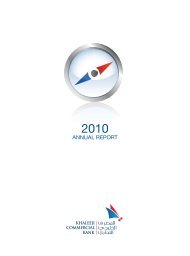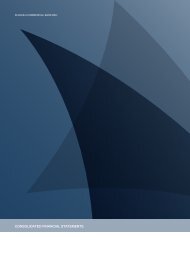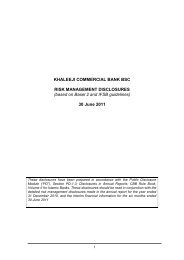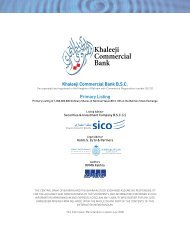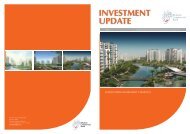2011 Annual Report - Khaleeji Commercial Bank BSC
2011 Annual Report - Khaleeji Commercial Bank BSC
2011 Annual Report - Khaleeji Commercial Bank BSC
You also want an ePaper? Increase the reach of your titles
YUMPU automatically turns print PDFs into web optimized ePapers that Google loves.
KHALEEJI COMMERCIAL BANK <strong>BSC</strong><br />
RISK MANAGEMENT DISCLOSURES<br />
2. Introduction to Basel II & Risk Management (continued)<br />
Pillar III<br />
Pillar III complements the other two pillars and focuses on enhanced transparency in disclosure of information by the <strong>Bank</strong>s to<br />
promote better market discipline. The information to be disclosed covers all areas including business performance, capital adequacy,<br />
risk management, etc. The disclosures are designed to enable stakeholders and market participants to assess an institution’s<br />
risk appetite and risk exposures and to encourage all banks, via market pressures, to move towards more advanced forms of<br />
risk management.<br />
In April 2008, the Central <strong>Bank</strong> published a paper covering the detailed disclosure requirements to be followed by licensed<br />
banks in Bahrain to be in compliance with Pillar III under the Basel II framework. This document is prepared in accordance with<br />
these directives.<br />
2.1 The risk management function<br />
The Board of Directors has overall responsibility for risk management in the <strong>Bank</strong>. The Board lays down the risk<br />
management policies of the <strong>Bank</strong> and quantifies its risk appetite through appropriate definitions of various risk limits<br />
and tolerances. The Board discharges its risk management responsibilities through the Board Risk Management<br />
Committee (“BRMC”).<br />
The Board has established an Executive Risk Management Committee (“ERMC”), which is responsible for developing and<br />
monitoring <strong>Bank</strong> risk management policies in the specified areas. The committee consists of heads of business and other<br />
functional units in the <strong>Bank</strong> and reports regularly to the BRMC.<br />
The day to day risk management functions are performed by the Risk Management Department (“RMD”) of the <strong>Bank</strong>.<br />
RMD is responsible to ensure that the policies laid down by the Board are consistently implemented across the <strong>Bank</strong> and<br />
to review the adequacy of these policies periodically. It monitors all risk taking activities and ensures that the risk limits<br />
defined by the Board are complied with. The department has specialized personnel dealing with Credit, Market, and<br />
Operational Risks. It is independent of all risk taking functions in the <strong>Bank</strong> and reports to the BRMC through the ERMC<br />
chaired by the Chief Executive Officer (“CEO”).<br />
The Asset Liability Management Committee (“ALCO”) of the <strong>Bank</strong> acting through the treasury department monitors<br />
the <strong>Bank</strong>’s liquidity position and recommends appropriate action to the Board where necessary. There is a high level of<br />
coordination between the RMD, ERMC and ALCO.<br />
The RMD prepares a risk overview report which covers in detail the various risks faced by the <strong>Bank</strong> and the same is<br />
discussed at the ERMC, BRMC and the Board on a quarterly basis.<br />
The <strong>Bank</strong> considers that its overall risk management strategies used has been effective throughout the reporting period.<br />
The RMD, together with the Internal Audit and Compliance departments, provides independent assurance that all types<br />
of risk are being measured and managed in accordance with the policies and guidelines set by the Board of Directors.<br />
82<br />
<strong>Annual</strong> <strong>Report</strong> <strong>2011</strong>



